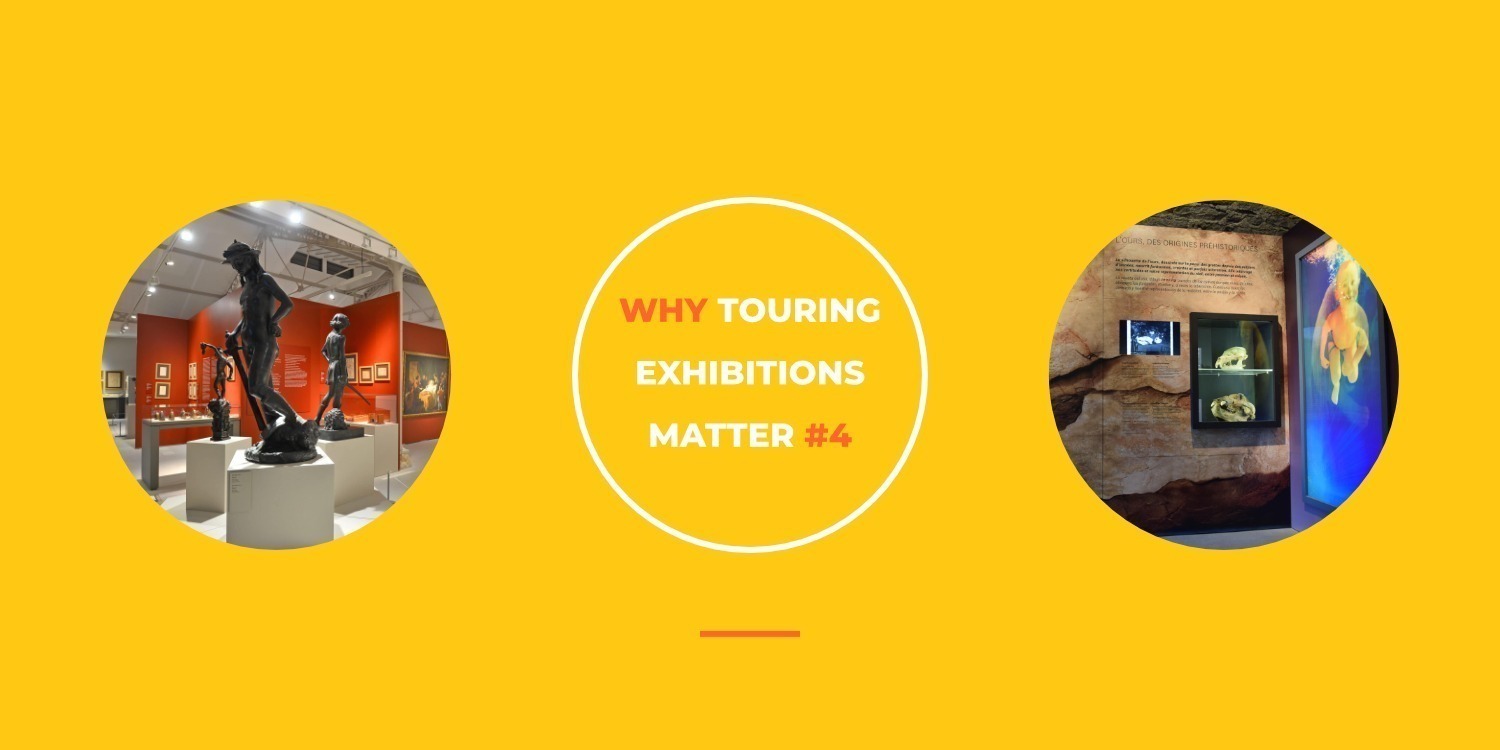#4 – Touring exhibitions as a source of internal engagement and new perspectives is the fourth article in the Why Touring Exhibitions Matter series by Teo. This series of articles aims to highlight the value of travelling exhibitions in the context of the multi-layered crisis cultural institutions and their audiences are currently facing. The series investigates how such creative productions and the collaborations they foster are essential sources of value for cultural institutions and their audiences at large, and how they will be, and already are, key resources for recovery in the cultural world and beyond. In this fourth article, we explore how travelling exhibitions can be strong resources to leverage for engagement with teams within cultural organisations and for the enrichment of scientific perspectives.
Touring exhibitions are distinct moments of interaction for teams within cultural organisations. Their development relies on collaboration between teams from producing organisations, teams from hosting organisations, and teams of satellite organisations who contribute to the project with specific outsourced skills at different times of its implementation. Every staff member involved in the process of developing an exhibition tour, in roles of different natures and intensities of participation, experiences a new professional project and new interactions, internally and externally. This new collaborative experience is a particular moment in the life of the cultural organisation, which can be leveraged for internal engagement and enrichment of perspectives.
These projects even often involve multi-organisational collaborations, where contributions from several venues on the same tour enhance the project and generate a full ecosystem of interactions and interdependencies.
Activating teams through new interactions
Touring exhibitions offer specific opportunities for internal teams within hosting and producing organisations to engage in external collaborations, of different scales depending on the project – locally, nationally and internationally. These productions trigger an encounter, often at all levels within an organisation and between departments from different institutions, who will have to work together on all aspects of the exhibition’s development. Organisations participate with different levels of involvement depending on the service proposed by the producing organisation – from a full turnkey service to a tailored collaboration. Exhibitions and administration teams, curators and collection specialists, leadership and technical staff, education and communication departments, and researchers and shop managers from both the producing and hosting institutions have to work together for the tour to become a reality. These projects even often involve multi-organisational collaborations, where contributions from several venues on the same tour enhance the project and generate a full ecosystem of interactions and interdependencies. This is particularly true in the context of a co-production, but is also the case for more classic tours, where each venue can have direct or indirect points of contact with the other venues as part of a global tour project.
Beyond these interactions with producing and hosting partners, touring exhibitions also enable new external collaborations for hosting and producing teams, prompted by the new project. Existing and new partners come on board to supply services and solutions for the project or to contribute to its activation: for example, specialists who produce and install display equipment that is not provided by the producer; artists, creatives and associations who get involved in the development of satellite programmes around the exhibition; or local authorities and partners, for whom the project can be a new space for collaboration as part of the ongoing relationship with the institution.
Touring exhibitions also naturally foster internal relationships within the participating organisation. Managing a new project can be an internal collaboration context that reinforces existing internal interactions, particularly within existing teams that already work regularly or continuously together on internal projects. It can also trigger new types and frequencies of collaborations across different departments and levels of seniority within an organisation. With each new exhibition to be welcomed or produced comes a chance to create new teams across the organisation, and it can thus contribute to strengthening the quality and knowledge of, and commitment to, the organisational culture.
Participating teams have the opportunity to share their own and experience their partners’ approaches, as well as develop new ideas and ways of working in collaboration with the members of their new ephemeral team.
Fostering upskilling and internal engagement
If well thought out, internally communicated and allocated with a fair workload, as a strategic avenue for internal engagement, the hosting and production of touring exhibitions can be a strong asset when it comes to motivation, learning and upskilling across the teams involved in the project.
As complex projects which require a broad set of skills from both the producing and hosting sides, travelling exhibitions have the potential to expose teams to new knowledge and new practices in exhibition making. Participating teams indeed have the opportunity to share their own and experience their partners’ approaches, as well as develop new ideas and ways of working in collaboration with the members of their new ephemeral team.
They are confronted with complexities and levels of uncertainty that can be quite different to what they are used to when managing internal projects. “It is not uncommon for exhibitions teams to experience miscommunication, lack of information and disagreement (Office of Policy and Analysis 2002). If this happens for teams working in the same institution, then a multi-venue, international level collaboration might expect significant challenges exacerbated by “the hurdles of distance, language, and cultural differences” (McLeod O’Reilly 2005, 252) as well as different time zones and institutional timeframes, political contexts, ideas about audiences and ways of working”1.
Working on touring exhibitions, particularly international ones, can be a unique opportunity for internal stakeholders to develop new skills and reinforce a variety of existing soft skills, areas of knowledge and know-how, through formal and informal, direct and indirect interactions. For example, there are clear opportunities to develop new project management skills, with new agility and uncertainty management skills. Intercultural management is also at the heart of touring collaborations, which offer occasions to learn from interaction with different cultures – national and societal cultures, organisational cultures, and work cultures.
Multiple perspectives
Touring exhibitions also have the potential to be a rich source of upskilling in content and programme development. They provide possibilities to learn, for instance, how to envisage a diverse international audience, rather than focusing on a familiar local audience. They are a resource for the development of new scientific knowledge and programmes, not just in the discovery of partners’ research and content, but also in the co-creation of new content with partners, and in the different research avenues encouraged by the widening of audiences. These collaborations can be particular moments, which show how much knowledge is a living resource, continuously nurtured with new perspectives.
International collaborations activated by touring exhibitions can provide hosting and producing teams with access to multiple perspectives on research and exhibition themes. Such collaborative projects make it possible for teams to go beyond the skills, research focuses and collections which are present within their organisations. They can engage with meaningful collections, topics and research at a wider scale – and bring these to their local audiences and stakeholders, with tailored adaptations that they implement in the collaboration. If these external resources are chosen by the hosting institution for their ability to match its mission, and to help the team carry out the institution’s mission, the interactions thus triggered can bring a new sense of, new experience of, and new commitment to the raison d’être of the institution.
Every touring exhibition is a unique human adventure, an encounter of skills, experiences, cultures and perspectives. This very specific moment in the life of an open institution can be a particularly favourable context in which internal stakeholders can build inspiration, meaning, motivation and skill – a driving force for professional development, team building and emotional commitment to the organisation. Particularly in the context of the current multi-layered crisis, touring exhibitions can be considered an asset by lowering pressure on internal production and providing fresh incentives for internal engagement.
Sources
1 Davidson, L., & Pérez-Castellanos, L. (2019). Cosmopolitan Ambassadors: International exhibitions, cultural diplomacy and the polycentral museum. Wilmington, Delaware, USA: Vernon Press.
Exhibitions featured in the cover image
Bears, by Museum d’Histoire Naturelle de Toulouse
Léonard de Vinci et la France, by Château du Clos Lucé – Parc Leonardo da Vinci
About the authors & contributors
Teo is the global resource for the international touring exhibitions community. Created for hosts, producers and suppliers of international touring exhibitions, Teo is a global living resource for sharing best practices and fostering new international collaborations in the world of travelling exhibits.



